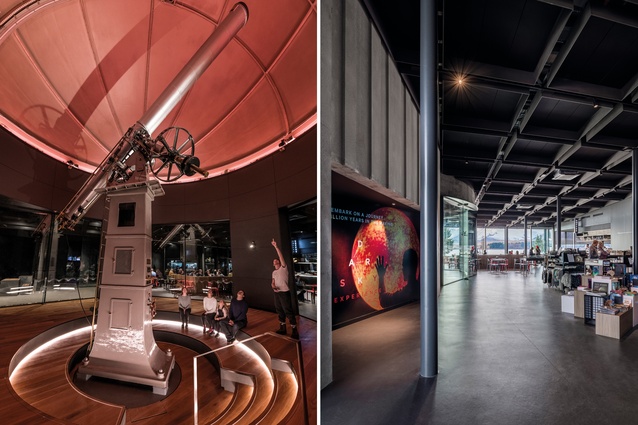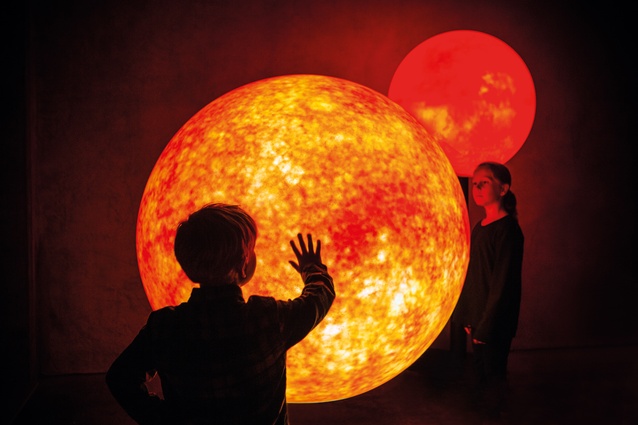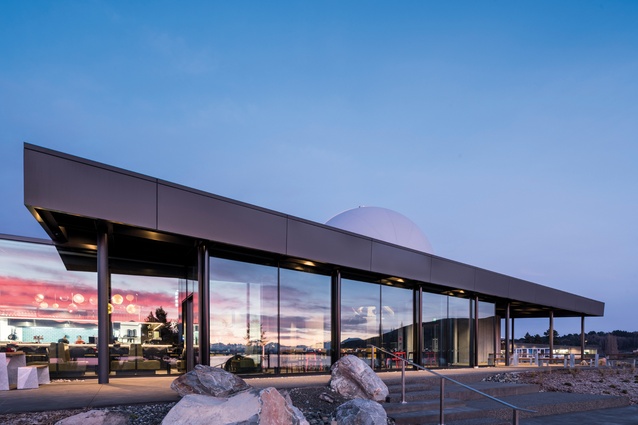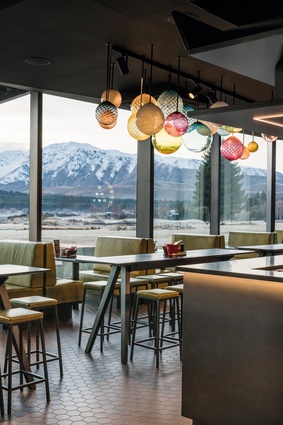New-age stardom: Dark Sky Project
Abigail Hurst explores Takapō’s brightest star, a new project by Sheppard & Rout Architects.
On the shores of Lake Takapō (Tekapo), a new star has been born and he is bigger and brighter than others on the township’s horizon. Rehua sits here, impressive in his proud, uncompromising appearance but humble in scale and colouring: a reflection of context but also a distinctive object in his own right.
Rehua is the Dark Sky Project – a new centre for astro-tourism deep in the Aoraki Mackenzie Basin in the centre of the South Island, where an area of 4300km2 was declared an International Dark Sky Reserve in 2012.
It’s the result of a partnership between stargazing and observatory tour operator Dark Sky Project (formerly Earth & Sky) and Ngāi Tahu Tourism. It was the rūnanga of Ngāi Tahu – Arowhenua, Waihao and Moeraki – who gave the building its name. To Ngāi Tahu, Rehua is the eldest child of the gods, the first-born from Papa (the Earth) and Rangi (the Sky). Also known as Antares, Rehua is the brightest star in the constellation of Scorpius and is the star from which all knowledge comes – a fitting name, particularly in relation to the building’s kaupapa (key purpose), which is educating visitors about the night sky.

Designed by Sheppard & Rout Architects, the building is inspired by the site’s majestic setting and conceived as the meeting of earth and sky. The floor, the earth, rolls powerfully in, with the ribbed pre-cast, curved, concrete walls reminiscent of the glacial giants that created Takapō. The roof, though simplified during value engineering to a mono-pitched plane, retains its expression of Einstein’s space-time continuum, with a grid formed to the exterior soffit and internal ceiling like a dark sky hovering over.
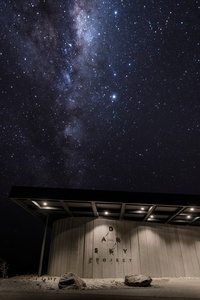
The proposal, which broke many of the strict design guidelines for new buildings in Takapō (including height limit, roof pitch and materiality of the external envelope), required a complex resource consent. However, the building speaks more of its place than do some others nearby that do meet council criteria, especially in the way it echoes the language of the terrain as a finely tuned interpretation of the landscape.
An unmistakable part of this articulation is the 10.9m-high, seven-tonne dome that houses the Brashear Telescope. This 125-year-old, 8m-long piece of equipment, which arrived in New Zealand in October 1963 as a gift from the University of Pennsylvania, has finally found a home equal to its size and splendour after more than five decades in storage. Three 3.8m-tall windows (two internal and one exterior, forming part of the external envelope) ensure the Victorian masterpiece is visibly accessible to all who visit.
The telescope is mounted to a base, which is separated from the rest of the building so no transference of nearby footfall vibrations can affect its finely attuned alignment. This bespoke baseplate has been designed to protect the historic instrument during a seismic event by way of a controlled rocking mechanism and it can be easily re-levelled after the event. The indoor experience for visitors involves presentations of research conducted by the University of Canterbury at Mount John Observatory, as well as giving a stage to the local Māori stories of the stars in a masterful interweaving of science and mythology.

The multimedia indoor astronomy experience, culminating in an up-close encounter with the Brashear Telescope, is contained in zones adjacent to the reception area and retail space, while the staff offices, meeting rooms, commercial kitchen and utilities are more tightly clustered on the opposite side of the building. The diner overlooks the lake and towards the iconic Church of the Good Shepherd, an important visual connection. The main entry and bus stop are on the south side. It is from this point, stargazers are transported to further tours.
Standing in the main foyer, the entirely matte black interior seems a little bland in its sameness – had the floor finish been a more raw materiality, this space would have tied in the concept of earth more successfully. The envisioned arrangement of glacial-shaped furniture in the architect’s first sketches was unfortunately reduced to a retail display.
However, the Dark Sky Project was never a building intended to be about itself but, rather, a window from which to look at the universe, and it forms the frame well. Like the legendary telescope it contains, this construction is a lens with which to see: an instrument pointing to the pursuit of knowledge about our skies. Its placement and outlook are part of the Mackenzie District Council’s larger plan to reorientate the town to the lake. This path is not without controversy and is one which has had to be carefully navigated – the tavern situated in the lot behind is not so pleased to have its lake view gone. In time, it is hoped that the under-utilised shore will be activated further by planned new buildings and programmes, and this project is a stride in this direction.

An ever-orbiting question – what is New Zealand architecture? – is often answered by looking to the landscape for inspiration. However, perhaps it is not only the locational context but also the specific culture and story of the land that should be embodied. This project has succeeded in doing just that. Its form would not look right one hour east on the Mackenzie plains nor one hour south in the dry and dramatic Lindis Pass.
It makes sense here, between the glacial carved natural forms of the mountains and the unparalleled expanse of the sky. The story it tells is one told by its people, creating an immersive experience of the culture and values that epitomise this region.
The skies have long been used by our ancestors to navigate our land and seas and, here, they have been used to steer architecture – the Dark Sky Project’s careful balance of function and form is a celebration of this history.
Will the building be outgrown in time? Since it is on the cusp of a new age of star-centred and Instagrammable tourism, probably. But, for now, it is of an apt scale for the town: the largely horizontal format, harmonious with its poetic surroundings, and the dome a proud new symbol for astro-tourism and the place of Takapō. The building is, in many ways, a star itself, captivating the imagination and directing those who visit it to knowledge found in the skies.
This article first appeared in Architecture New Zealand magazine.





